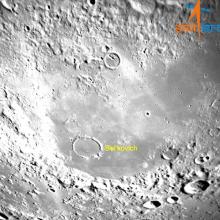Listen to today's episode of StarDate on the web the same day it airs in high-quality streaming audio without any extra ads or announcements. Choose a $8 one-month pass, or listen every day for a year for just $30.
You are here
Moon and Pollux
When a big space rock slammed into the southern hemisphere of the Moon about 110 million years ago, it created quite a mess. It gouged a crater that’s more than 50 miles wide and three miles deep. It sprayed out rock that created streaks up to a thousand miles long. And it even blasted material all the way to Earth — perhaps enough to form a thin layer across the entire planet.
The crater is known as Tycho. With its bright “rays” of debris streaking away from it, it’s visible to the unaided eye, and an easy target for binoculars.
A ring of darker material encircles the brighter crater. That’s probably glass — rock that melted during the impact that created the crater.
Apollo astronauts picked up samples from the rays, hundreds of miles from the crater itself. The robotic Surveyor 7 spacecraft landed inside the crater in 1967. NASA was considering sending Apollo 20 to Tycho as well, but the last three Apollo missions were scrapped, leaving the crater unexplored.
As much as 20 cubic miles of rock and dirt from the impact could have settled on Earth. A recent study looked for some of that debris in ocean sediments. It didn’t find as many likely samples as expected, but the search continues — for bits of the Moon here on Earth.
Tonight, look for the Moon near the bright twin stars of Gemini. The brighter twin, Pollux, is to the lower left of the Moon at nightfall, with slightly fainter Castor above Pollux.
Script by Damond Benningfield






